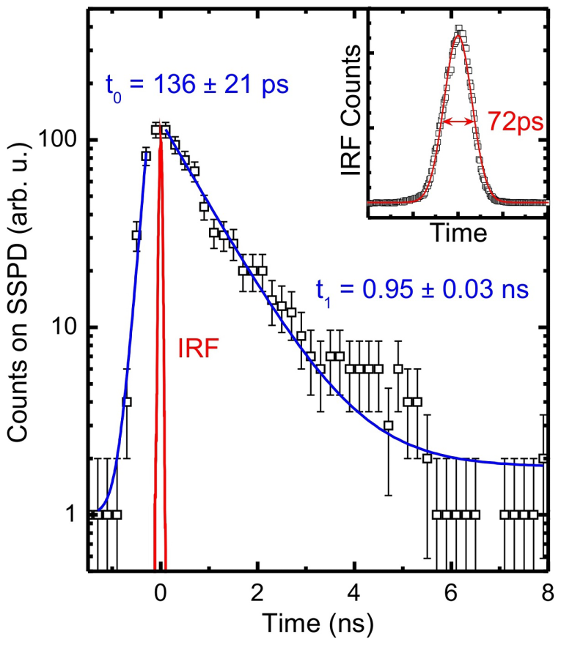We report the routing of quantum light emitted by self-assembled InGaAs quantum dots (QDs) into the optical modes of a GaAs ridge waveguide and its efficient detection on-chip via evanescent coupling to NbN superconducting nanowire single photon detectors (SSPDs). The waveguide coupled SSPDs primarily detect QD luminescence, with scattered photons from the excitation laser onto the proximal detector being negligible by comparison. The SSPD detection efficiency from the evanescently coupled waveguide modes is shown to be two orders of magnitude larger when compared with operation under normal incidence illumination, due to the much longer optical interaction length. Furthermore, in-situ time resolved measurements performed using the integrated detector show an average QD spontaneous emission lifetime of 0.95 ns, measured with a timing jitter of only 72 ps. The performance metrics of the SSPD integrated directly onto GaAs nano-photonic hardware confirms the strong potential for on-chip few-photon quantum optics using such semiconductor-superconductor hybrid systems.
Photonic information technologies using semiconductors are ubiquitous and are rapidly being pushed to the quantum limit where non-classical states of light can be generated and manipulated in nanoscale optical circuits1,2. Single photons can be readily generated on-chip3 and preferentially routed into waveguide modes by carefully tailoring the local density of photonic modes experienced by the emitter4–6. Furthermore, effective interactions between photons can be induced by exploiting coherent light-matter couplings between the tightly localized vacuum field in nanoscale cavities, leading to remarkable phenomena such as photon blockade7,8 needed for optical transistors9,10 and ultrafast optical switching with only a few photons11. While the generation and routing of quantum light on a semiconductor chip3,12,13 has already been demonstrated by several groups, the ability to generate and detect single photons on-chip with near unity quantum efficiency14 and, moreover, integrate sources and detectors with nanophotonic hardware such as waveguides, high-Q nanocavities and beamsplitters would represent a major step towards the realization of semiconductor based quantum optical circuits.
In SSPDs, photon detection occurs via the formation of a normal conducting hotspot in a thin superconducting nanowire upon the absorption of a single photon15. Since the bias current flowing through the nanowire is slightly sub-critical (*0:95 Icrit), the local heating arising from single photon absorption results in the breakup of Cooper pairs, local switching of the nanowire to a normal conducting state and a measurable voltage pulse in the external readout circuit. Such SSPDs provide very high single photon detection efficiencies14,16–19, low dark count rates20, sensitivity from the visible to the IR21 and picosecond timing resolution22,23. The possibility to integrate superconducting single photon detectors (SSPDs) onto dielectric1,14 and plasmonic2 waveguides results in a drastic increase of the absorption length for incoming photons, pushing the single-photon detection efficiency towards unity. Both the generation of cluster states of photonic qubits for one-way quantum computation24 and the measurement based teleportation schemes25 rely on having such near perfect detection efficiency.
SSPD is about two orders of magnitude more sensitive to waveguide photons than when illuminated in normal incidence. In-situ time resolved measurements performed using the integrated detector show an average QD spontaneous emission lifetime of 0.95 ±0.03 ns, with a low timing jitter of only 72 ±2 ps. The performance metrics of the SSPD integrated directly onto GaAs nano – photonic hardware confirms the strong potential for on-chip few-photon quantum optical experiments on a semiconductor platform2 .
Spatially resolved photoluminescence (PL) measurements were performed whilst the sample was held at a nominal temperature of 4.2 K inside a cryogenic microwave probe station with optical access. This system provides a diffraction limited laser spot with a diameter of , 5 mm and allows the SSPD to be contacted using GHz voltage probes, thus, facilitating in-situ detection of PL routed along the waveguide. Data recorded using this measurement system is termed on-chip PL in the discussion below. For the operation conditions of the SSPD, as described in the methods section, the integrated detector shows a negligible dark count rate , 10 cps and a topillumination detection efficiency of 0.001% for light at 940nm, as expected for the relatively thick 10 nm NbN film. This efficiency was estimated from the registered single photon events divided by the number of photons incident upon the active device area19. The active area of the device is given by the fractional areal coverage of NbN 280nm wide nanowires with a separation of 170 nm corresponding to a fill-factor of 32%. As discussed below, the detection efficiency for waveguide photons is about two orders of magnitude larger due to a significantly longer interaction length. Additional PLspectroscopy measurements were performed on the same sample with excitation and detection normal to the waveguide axis using low temperature confocal microscope with a much higher spatial resolution (1mm). PL-spectra are obtained by dispersing the emitted light using a 0.5 m imaging monochromator and detected using a silicon CCD detector. In the following, such measurements are termed confocal-PL.

Fig1
In summary, we presented the creation, routing and detection of single quanta of light on a single chip. Using a waveguide coupled SSPD detector we showed that on-chip PL provides a detection efficiency of ~0.1% for evanescently coupled light which gives a signal enhancement of two orders of magnitude when compared to topillumination of the device. Moreover, it was shown that the integrated detector can be employed to perform in-situ time resolved measurements at a temporal resolution of 72 ps, thereby revealing an average exciton lifetime of 0.95 ±0.03 ns and a rise time of 136 ±21 ps. The great potential of this highly integrated quantum optics system can be fully used when additionally implementing the spectral resolution of SSPDs7 or when performing resonant excitation experiments with single quantum dots.
上一篇: 低阈值光子晶体激光器
下一篇: 用单片集成半导体激光芯片直接产生宽带混沌